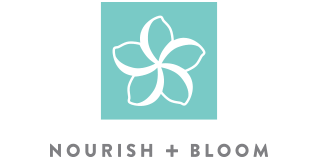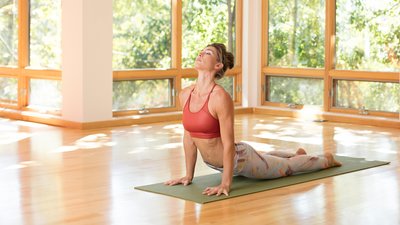Poor posture is one of the biggest culprits for back pain and neck discomfort. Long days hunched over a computer or hours standing incorrectly can lead to a whole slew of physical ailments, from breathing issues to degenerative injuries like joint immobility, trouble sleeping, increased anxiety, migraines, and even vision problems.
Thankfully, poor posture is fixable. Yoga has been found to be an effective way to both properly align and increase support to postural muscles. All of which means less pain for you! The yoga poses below are intended to open the chest, release shoulder tension, stretch tight hips, and increase strength in the back and core muscles, which will help combat symptoms of poor posture. Each pose comes with its own sets of benefits and challenges, so remember to breathe and be kind to your body as you move through your own practice.
Pose 1: Mountain Pose (Tadasana)
Mountain pose is an active pose that enforces proper alignment. While it looks easy, performing it correctly requires complete engagement of all muscles and is often a challenge to hold and maintain. It's also great for body awareness and sensing your proper body positioning.
The goal of the pose is to find an active and neutral balance. Stand with feet shoulder- or hip-width apart and ensure the four corners of your feet are actively engaged on the ground and parallel to each other. Activate your legs and lengthen your tailbone to provide a stretch from the tip of the tailbone to the top of the head. Engage your core and relax and open your shoulders. Your arms should be active, but hanging down so your hands are even with your hips. Allow your palms to face forward or, if your shoulders are especially tight, face your body. Keep your head straight and in line with your spine, right on top of your hips. Breathe fully, allowing your chest to fully expand and retract throughout the pose, activating the core a little more with each exhale. Begin with 15-second holds and climb up from there.
Pose 2: Wide-Legged Forward Bend (Prasarita Padottanasana)
The wide-legged forward bend will help release shoulder and neck tension and allow a deep stretch of the posterior chain. If you've had previous lower-back injuries, you may want to skip this one!
This stretch is best and safest when you've already warmed up a bit. Begin in Mountain Pose and step the feet apart. Your feet should be several inches wider than your shoulders. Ground the feet and begin activating your muscles, starting from your feet and moving up. Once every muscle is completely engaged, inhale deeply and interlace your hands behind your back. Perform a very slight back bend, then allow your upper body to bend forward. Maintain a tight core as you bend forward leading with your chest until you're as far forward as you can go. Keep your fingers interlaced as you bend forward and allow them to lift off your back as you see fit.
Once you've bent forward as far as is comfortable, release neck tension and swing your upper body gently back and forth. Breathe throughout the pose and maintain a comfortable, yet steady inhale and exhale. Engage the core and slowly reverse the pose the same way you bent forward. Once standing, unclasp your hands and gently shake free any tension from your arms and legs. Repeat 1-3 times, beginning with 30-second holds.
Pose 3: Baby Cobra (Ardha Bhujangasana)
As a chest opener and hip stretch, you can't beat the baby cobra.
Begin on your belly with your hands under your shoulders, and your elbows tucked into your body. Extend your legs behind you and keep them about hip-width apart. While keeping your belly on the ground, engage your middle back and gently peel your chest off the ground. Keep your head between your shoulders, and keep your shoulders relaxed and away from your neck. Inhale deeply and return your chest to the ground. Repeat 2-4 times.
Pose 4: Bridge (Setu Bandha Sarvangasana)
Bridge pose is perfect for relaxing the shoulders, opening the chest, and releasing the hips. It can also be an excellent glute and hamstring activator, which is important for anyone who sits for long hours.
Lie on your back with your arms by your sides and your palms down. Your knees should be bent and your feet firmly planted on the ground. Press through your heels and engage your glutes to lift your hips toward the sky. Do not allow your knees to drift out or in. Keep your shoulders and head on the ground, but lift your chin slightly to ensure proper breathing and alignment. If you need some modification, place a block under your lower back. Or, if you need to make it more difficult, roll your shoulders back and clasp your hands together under your hips after you raise them. Repeat 1-2 times, beginning with 30-second holds.
Pose 5: Cat-Cow (Marjaiasana to Bitilasana)
Free movement and gentle stretching releases tension in the spine, hips, core, and neck.
Begin on your knees with your hands planted firmly on the ground under your shoulders. Your core should be engaged and your knees should be under your hips. Inhale deeply into the sides of your ribs. During a slow exhale, drop your belly, allowing your head and tailbone to point up toward the sky. On the next inhale, articulate through your spine by curling your tailbone toward the ground and curling your spine until your head tucks toward your chest. Repeat these movements on every inhale and exhale for 30-60 seconds.


